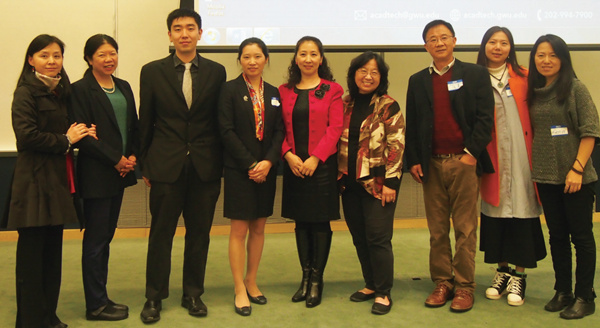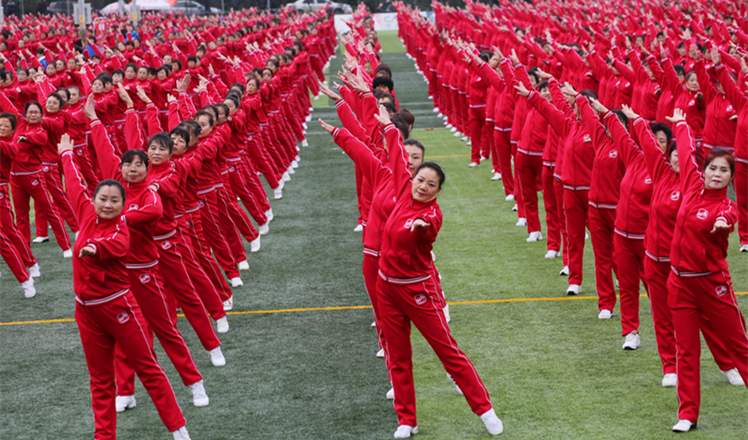Chinese-language teachers debate exam's fine points
Updated: 2016-11-08 00:15
By China Daily in Washington(China Daily USA)
|
|||||||||
 |
|
Xu Xin (third from left), president of the Chinese Language Teachers Association National Capital Region (CLTA-NCR); Lucy Chu Lee (sixth from left), professional consultant for the National Commission for the AP World Languages Course and Exam Review Project and other CLTA-NCR members gather at the association's fall conference last Saturday in Washington. The conference presented information about the Advanced Placement Chinese Language and Culture Exam for Chinese-language teachers around the Washington area. Yuan Yuan / For China Daily |
In a show of dedication, Chinese-language teachers debated the grading of a sample answer on the writing section of an advanced placement test.
The teachers gathered last Saturday at the fall conference of the Chinese Language Teachers Association National Capital Region branch in Washington.
"Today we sow the seeds; hopefully all of you'll be able to share what you've learned from today with other teachers," said Xu Xin, president of the NCR branch.
The Chinese Language Teachers Association (CLTA), a professional organization devoted to the study of Chinese language, culture and pedagogy, was established in 1962.
In response to an increase in Chinese-language learners in the US, especially after the 2008 Beijing Olympics, the association's National Capital Region (NCR) branch was established in 2009 to bring Chinese-language teaching resources together and create a platform for teachers in the region to exchange ideas and thoughts.
The branch comprises teachers from elementary schools to universities and from public and private schools.
In addition to regular meetings, the teachers hold conferences twice a year, usually with a few speakers giving their perspectives on a chosen topic.
"This spring, we talked about technologies in the classroom for a larger audience," Xu said. "Instead, this time, we choose to discuss AP teaching intended for a specific niche audience."
They invited Lucy Chu Lee, a consultant to the National Commission for the AP World Languages Course and Exam Review Project, as the keynote speaker to talk about how to design Chinese lessons using authentic texts.
"When I started to teach Chinese in 1988, we used to compete on how many characters we had taught to our first graders," Lee said. "But that didn't necessarily reflect what our students had learned."
"After all these years, I realized that we need to prove the usefulness of learning Chinese to our students in order to keep them going, and the AP exam is a strong proof of that," she said.
The Advanced Placement (AP) Chinese Language and Culture Exam (which was the discussion topic) assesses interpersonal, interpretive and presentational communication skills in Mandarin Chinese, along with knowledge of Chinese culture, according to its official website.
Similar to TOEFL (Test of English as a Foreign Language), the AP Chinese exam includes listening, reading, writing and speaking sections.
"The AP courses serve as a transition between high school and college," Lee said. "And we want to make sure that the AP exam is fair and reflects the actual situation of the high school students."
High schoolers who have completed their required credits are able to take AP Chinese courses to either transfer into college credits or to waive entry-level courses later in college.
The ultimate goal of teaching Chinese, according to Lee, is to enable the students to actually communicate with others in Chinese when being thrust into a Chinese-language environment.
"Field trips to China would be the best way to immerse students into the Chinese-language environment," Lee said. "Even if the situation doesn't allow such field trips, we want to provide the students with real context of Chinese conversations; that's our responsibility."
Teachers need to provide specific and practical goals along the way so that students understand the objectives, she said.
Three local speakers also provided insights on how to effectively teach AP Chinese courses.
NCR Vice-President Liang Hui illustrated the culture triangle: product, practice and perspective in teaching AP with examples.
"I used to throw dumpling parties at home with my students during the Spring Festivals since making dumplings was probably their favorite activity," Liang said.
"In this case, dumpling is considered a cultural product and teaching them how to make dumplings is a cultural practice. In order to help them gain perspectives, I need to add a little bit backgrounds on why we made dumplings for Spring Festival," she said.
She pointed out that in language teaching, the often-overlooked component was to teach perspectives — the back stories related to language learning.
"It's important for us to make Chinese into a mainstream second language in the US," Lee said.
That's what Hanban, or the China National Office for Teaching Chinese as a Foreign Language, is trying to do by sending out teachers from China, developing Chinese proficiency tests and setting up Confucius institutes.
"Also, we want to increase the number of non-Chinese teachers to join in our force to promote Chinese," Lee said.
"That way we achieve real globalization of the Chinese language — no matter what native languages or backgrounds they have, they can learn Chinese well enough to make it a profession," she said.
Yuan Yuan in Washington contributed to the story.
- Summit of Climate Conscience kicks off in Morocco
- British Airways announces special fares for New Year
- S. Korean president says to accept investigation over scandal if necessary
- Names of twin panda cubs born in Austrian zoo revealed
- May's Brexit plans thrown into chaos by landmark court ruling
- Syrian army announces 'humanitarian pause' on Friday

 Premier Li visits the State Hermitage Museum
Premier Li visits the State Hermitage Museum
 Hogwarts-like assembly hall attracts visitors to Zhejiang University
Hogwarts-like assembly hall attracts visitors to Zhejiang University
 50,000 people set new Guinness square dance record
50,000 people set new Guinness square dance record
 Top 10 congested cities in China
Top 10 congested cities in China
 The final take: Trump vs Hillary
The final take: Trump vs Hillary
 Want to experience weightlessness? Try this ride
Want to experience weightlessness? Try this ride
 15,000 paintings, 5,000 candidates, one test
15,000 paintings, 5,000 candidates, one test
 Creating waves with stunts
Creating waves with stunts
Most Viewed
Editor's Picks

|

|

|

|

|

|
Today's Top News
US election rhetoric unlikely to foreshadow future US-China relations
'Zero Hunger Run' held in Rome
Trump outlines anti-terror plan, proposing extreme vetting for immigrants
Phelps puts spotlight on cupping
US launches airstrikes against IS targets in Libya's Sirte
Ministry slams US-Korean THAAD deployment
Two police officers shot at protest in Dallas
Abe's blame game reveals his policies failing to get results
US Weekly

|

|









